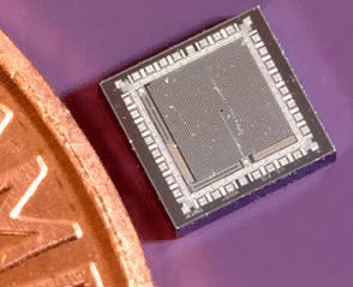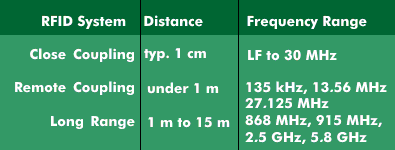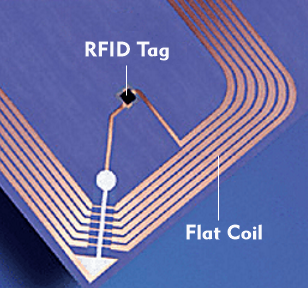RFID tag
RFID tags are small transponders that contain the RFID markings as stored data and transmit it by radio to RFID readers. RFID tags contain the processor, memory and the transmitting/receiving device.
The RFID tag's memory has a storage size between 8 bytes and 8 KB, and the transmitting/receiving device is tuned to a specific RFID frequency, depending on the application. Most RFID systems operate in the ISM bands at frequencies of 125 kHz and 13.56 MHz.
The size and possible applications of RFID tags
The size of tags can range from 1 mm to the size of a smart card, and their weights can range from 0.1 g to 10 g. In the meantime, there are RFID tags with dimensions as small as 0.3 mm. These are already referred to as smart dust. The smallest RFID tags are therefore suitable for implantation in animals and humans. Tags are attached to goods, pallets, containers, boxes, people or animals for identification purposes and are also used in RFID cards, e-passports and in access control systems.
Passive and active RFID tags
RFID tags are divided into passive and active tags, pre-programmed, writable and readable.
Passive RFID tags do not have their own power supply; the supply voltage is transmitted via radio from the reader to the tag. When a tag is activated, it sends its signals back to the reader. The readout time is in the millisecond range and the bridgeable distance depends on the RFID frequency and the RFID transmission. In terms of application, passive RFID tags are designed for near- field communication. A distinction is made between close coupling tags, which require direct interaction to access the stored data, and remote coupling tags, which can be activated at a distance of approximately 1 m. Since passive RFID tags are only suitable for near-field communication, it is not possible to read them from greater distances. In logistics, the two systems mentioned are rarely used; here, the Long Range RFID systems are used, which can be read and written to from greater distances.
In contrast to passive tags, active RFID tags have their own power supply and can transmit their stored RFID data on demand.
To protect writable RFID tags against misuse, they have been divided into several classes: Class-0 tags are passive and are programmed by the manufacturer. Class 1 tags can be reprogrammed and operate at UHF and HF frequencies. And Class-3 tags correspond to semi-passive radio tags.
RFID tags are specified in various International Standards Organization( ISO) standards. EPCglobal is actively involved in the standardization of RFID technology and deals with product identification in international goods traffic. The Electronic Product Code( EPC), which is used worldwide, is used for product identification.
In the transitional period, a combination of RFID technology and barcode is used for product labeling and is referred to as smart labels or electronic shelf labels( ESL). In addition to RFID, these also contain the printed information of the bar code, which can be read by a bar code reader.



